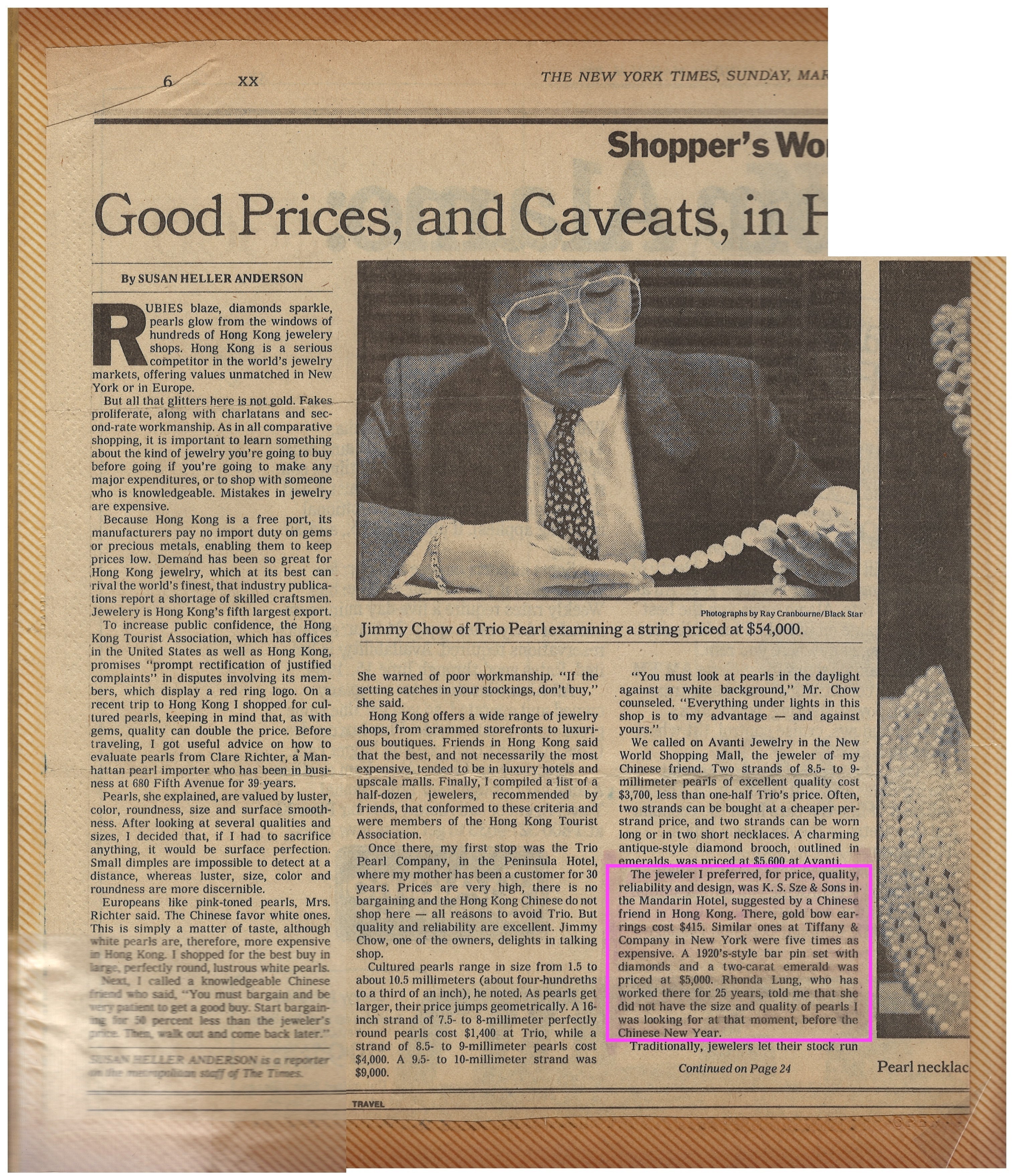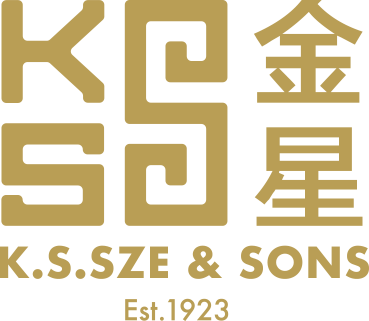New York Times - K.S. Sze & Sons

The New York Times
Good Prices, and Caveats, in Hong Kong
UBIES blaze, diamonds sparkle, pearls glow from the windows of hundreds of Hong Kong jewelery shops. Hong Kong is a serious competitor in the world's jewelry markets, offering values unmatched in New York or in Europe.
But all that glitters here is not gold. Fakes. proliferate, along with charlatans and sec-ond-rate workmanship. As in all comparative shopping, it is important to learn something about the kind of jewelry you're going to buy before going if you're going to make any major expenditures, or to shop with someone who is knowledgeable. Mistakes in jewelry are expensive. Because Hong Kong is a free port, its manufacturers pay no import duty on gems or precious metals, enabling them to keep prices low. Demand has been so great for Hong Kong jewelry, which at its best can rival the world's finest, that industry publications report a shortage of skilled craftsmen. Jewelery is Hong Kong's fifth largest export.
To increase public confidence, the Hong Kong Tourist Association, which has offices in the United States as well as Hong Kong, promises "prompt rectification of justified complaints” in disputes involving its members, which display a red ring logo.On a recent trip to Hong Kong I shopped for cultured pearls, keeping in mind that, as with gems, quality can double the price. Before traveling, I got useful advice on how to evaluate pearls from Clare Richter, a Manhattan pearl importer who has been in business at 680 Fifth Avenue for 39 years.
Pearls, she explained, are valued by luster, color, roundness, size and surface smooth-ness. After looking at several qualities and sizes, I decided that, if I had to sacrifice anything, it would be surface perfection Small dimples are impossible to detect at a distance, whereas luster, size, color and roundness are more discernible.
Europeans like pink-toned pearls, Mrs.Richter said. The Chinese favor white ones. This is simply a matter of taste, although white pearls are, therefore, more expensive in Hong Kong. I shopped for the best buy in large, perfectly round, lustrous white pearls. Next, 1 called a knowledgeable Chinese friend who said, "You must bargain and be very patient to get a good buy. Start bargaining for 50 percent less than the jeweler's price. Then, walk out and come back later.”
She warned of poor workmanship. "If the setting catches in your stockings, don't buy," she said.
Hong Kong offers a wide range of jewelry shops, from crammed storefronts to luxurious boutiques. Friends in Hong Kong said that the best, and not necessarily the most expensive, tended to be in luxury hotels and upscale malls. Finally, I compiled a list of a half-dozen jewelers, recommended friends, that conformed to these criteria and were members of the Hong Kong Tourist Association.
Once there, my first stop was the Trio Pearl Company, in the Peninsula Hotel, where my mother has been a customer for 30 years. Prices are very high, there is no bargaining and the Hong Kong Chinese do not shop here - all reasons to avoid Trio. But quality and reliability are excellent. Jimmy Chow, one of the owners, delights in talking shop.
Cultured pearls range in size from 1.5 to about 10.5 millimeters (about four-hundreths to a third of an inch), he noted. As pearls get larger, their price jumps geometrically. A 16-inch strand of 7.5- to 8-millimeter perfectly round pearls cost $1,400 at Trio, while a strand of 8.5- to 9-millimeter pearls cost $4,000. A 9.5- to 10-millimeter strand was $9,000.
"You must look at pearls in the daylight against a white background,"Mr. Chow counseled.
"Everything under lights in this shop is to my advantage - and against yours."
We called on Avanti Jewelry in the New World Shopping Mall, the jeweler of my Chinese friend. Two strands of 8.5- to 9-millimeter pearls of excellent quality cost $3,700, less than one-half Trio's price. Often, two strands can be bought at a cheaper per-strand price, and two strands can be worn long or in two short necklaces. A charming antique-style diamond brooch, outlined in emeralds was priced at $5.600 at Avanti.
The jeweler I preferred, for price, quality, reliability and design, was K. S. Sze & Sons in. the Mandarin Hotel, suggested by a Chinese friend in Hong Kong. There, gold bow earrings cost $415. Similar ones at Tiffany & Company in New York were five times as expensive. A 1920's-style bar pin set with diamonds and a two-carat emerald was priced at $5,000. Rhonda Lung, who has worked there for 25 years, told me that she did not have the size and quality of pearls I was looking for at that moment, before the Chinese New Year.
Traditionally, jewelers let their stock run down, and prices are lowered as well, just before the Chinese New Year, like our after-Christmas sales. Thus, you might find good buys but a smaller selection.
We went to Henry Jewelry, 43-45 Queen's Road Central. Eric Lam showed us two magnificent strands of 9- to 9.5-millimeter pearls for $11,000. Two strands of slightly less fine pearls were $5,000. The only visible differences to me were a few bumpy spots on the less-expensive strands.
Clasps are extra and can double the price of a necklace. A beautiful Ital-ian-made, round diamond-studded clasp shaped like a pearl, with .453 carats of diamonds, cost about $1,000 in Hong Kong. In New York, the identical item cost $1,500. If you bought a double strand of pearls and wanted them fully convertible from one long strand into two fitted chokers, you would require two clasps. Thus, you would save $1,000 on the clasps by buying in Hong Kong.
At Falconer Jewelers, in the Regent Hotel Lobby, I saw a lovely strand of pink-hued pearls, 9- to 9.5-millimeters, for $2,700. When I returned to New York, I dropped into Falconer's American branch at 1 West 47th Street. I was assured that prices were similar to those in Hong Kong. But a strand of the same size pearls, of lesser luster, cost $4,000. According to Mrs. Richter, a strand of perfectly round 9- to 9.5-millimeter pearls would cost $7,500 at most places in Manhattan.
Richard C. Reuter, a past president of the Cultured Pearl Association of America and president of Leys Christie & Company, a leading cultured pearl importer, cautions against buying in Hong Kong. "If you make a mistake 5,000 miles away, there's no way to recover," he said, adding that he believes Americans should buy from reputable American jewelers.
Hong Kong jewelry becomes even more of a bargain when you have things custom-made; jewelers will follow a photograph or drawing and will incorporate your own stones. A pair of large, 14-carat gold earrings copied from a pair of costume jewelry ones cost $380 from Mrs. Lung at Sze. A reasonably priced New York jeweler estimated his cost for making the identical thing at $850, in one to three days.
Since copying is a Hong Kong strength, bringing favorite costume jewelery to be copied takes some of the uncertainty out of having it made from a sketch.
When buying watches, remember that fakes abound and that one should buy only from authorized distributors of the top brands. Demand a receipt and the manufacturer's guarantee from the dealer.
I bought a slim gold Rolex man's watch with an alligator band for $1,800. After three days, it didn't work. My husband took it to Rolex in New York. He had the manufacturer's warranty, so Rolex repaired it free of charge. The same watch cost twice as much in New York.
By Susan Heller Anderson, 1989 March 26
